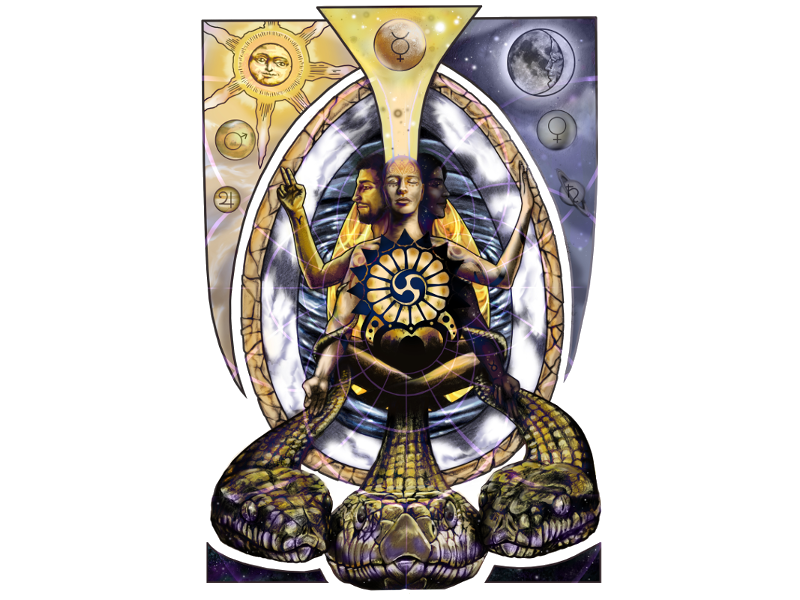Chemical Serpents: N'Aton and Sophia

Solve et Coagula digital art by @janiceduke
N'Aton
An entity appeared to three magicians, Nema, Louis Martinie and Herb Zigler, during a group working in the 1970s. None others present apparently reported meeting the entity. This entity appeared as androgynous, with golden skin, but with their right side always in shadow. The shadow side apparently contains different things at different times, including stars, human faces and symbols.
The entity revealed itself as N'Aton, apparently a gestalt or egregore of all humanity, from a possible future time when all humans will evolve a strange dual consciousness of being both individual and part of the whole simultaneously. It apparently includes any of our ancestors that lived in wisdom and helped our species survive and change, everyone currently living and all our future descendants.
A similar Gnostic hermaphrodite, Barbelo, the first feminine principle, but also known as 'Mother-Father', or metropater, the first human, the triple androgynous name and the eternal aeon. As an androgyne and the first human we can see a parallel to the Hebrew and Kabbalistic Adam Kadmon, the first man, made both male and female until separated into Adam and Eve. Adam Kadmon also appears in some Gnostic mythology as the Anthropos, or Adamas. In some Gnostic thought they embody the idea or mind of humanity, and the World-Soul.
In Sufi and Alevi teachings we also find a version of Adam Kadmon, Insan-i Kamil, the perfect or complete man. According to Abū Rayhān al-Bīrūnī, the word 'Sufi' itself derives from the Greek word for wisdom, Sophia.
Sophia
Hugh Schonfield argued in his book 'The Essene Odyssey', that the name Baphomet forms a Hebrew cypher for the Greek word Sophia. This could either reference the Gnostic goddess who bore that name, the abstract concept of wisdom, or to Sophia in the Christian sense of the Wisdom of God. This is interesting because in some Gnostic myths Sophia displays hermaphroditic qualities herself, by impregnating herself and giving birth to her child, Yaldabaoth, "Son of Chaos" or Samael. Also known as the Demiurge, the artisan, a being credited with claiming itself as the creator, when in fact it simply reorganised pre-existing material, either previously created by an elder god, or which other Gnostics considered uncreated and eternal.
The oldest references to the Demiurge however come from Platonism. Plato himself referred to the Demiurge in his 'Timaeus'. Plato however considered the Demiurge as benevolent, who works to manifest the will of the Monad, the One. Later Platonists revealed a secret meaning, the Demiurge as the mind or consciousness, organising our experience of the material world for the good. This contrasts with the later Gnostic view of the malevolent Demiurge.
Sophia also plays an important role in the mythology of various branches of Christianity, perhaps most notably Eastern Othodox churches, where many theologians consider Sophia part of the godhead. Sergie Bulgakov considers her as co-existent with the Trinity, a feminine aspect of God, although the authoritarian leadership of the Russian Orthodox church renounced this view as heretical.
Hildegarde of Bingen, a 12th Century Benedictine Abbess, who founded two convents on the Rhine, celebrated Sophia as a cosmic figure in both her writing and art.
In Protestant mysticism, we find Sophia of importance in the Philadelphia Society of Jakob Böhme and its derivatives, such as the Harmony Society of George Rapp. Here we find the Virgin Sophia, who Jane Leade claims revealed to her the workings of the Universe, whilst Böhme refers to Sophia as the Wisdom of God.
Of course, Sophia impregnating herself may not be a reference to a hermaphrodite nature so much as parthenogenesis, or virgin birth. From the Christian mysticism point of view this would connect her to the Virgin Mary, although from a biological viewpoint parthenogenesis usually occurs when a female finds herself in a remote location away from any males of her species. When she does this she invariably creates a male offspring, otherwise genetically identical to herself.
This biological behaviour has been verified in animals as complex as Komodo dragons, hammerhead sharks and turkeys. In mammals parthenogenesis has been artificially induced in rabbits although none so far have been found to do so in the wild. Furthermore reproduction of this kind would likely lead to increased risks of deformities and other developmental abnormalities. This may correspond to the Gnostic conception of the Demiurge as being born blind and so monstrous even his mother abandoned him.
In one of the later versions of the birth of Hephaestus, Hera gave birth to him parthenogenetically in a competitive quarrel with Zeus for his automatic birthing of Athena, (like Sophia, a goddess of Wisdom), but who then rejects him for his deformity, and throws him from Mount Olympus. Whilst other myths give various other reasons for his fall, and varying accounts of whether his lameness was the cause or result of it, but at least one version seems to parallel the Gnostic myth. Furthermore, Hephaestus later makes a net to trap his wife Aphrodite with her lover Ares when he realised she was cheating on him. The Gnostic story parallels this with Yaldabaoth capturing the spirits of Adam and Eve in his false creation, the garden of Eden. The serpent later teaches them to escape by eating forbidden fruit to reach gnosis and invoke a fiery angel that banishes the illusionary world.
To Plato, and his teacher Socrates, philosophy was understood as philo-sophia, the Love of Sophia, or the Love of Wisdom.
In Hebrew mysticism, Sophia was adopted as the Greek translation for Chokhmah, during the creation of the Septuagint, the first Greek translation of the Hebrew scriptures that later formed the old testament of the Christian bible.
Contents
Introduction
Serpents
Eggs and the Androgynous Child
- The Philosophers Egg and The Cosmic Egg
- The Monas Hieroglyph
- The Androgyne
- Baphomet
- N'Aton and Sophia
I feel enlightened
Don't worry, the feeling will pass... ;)